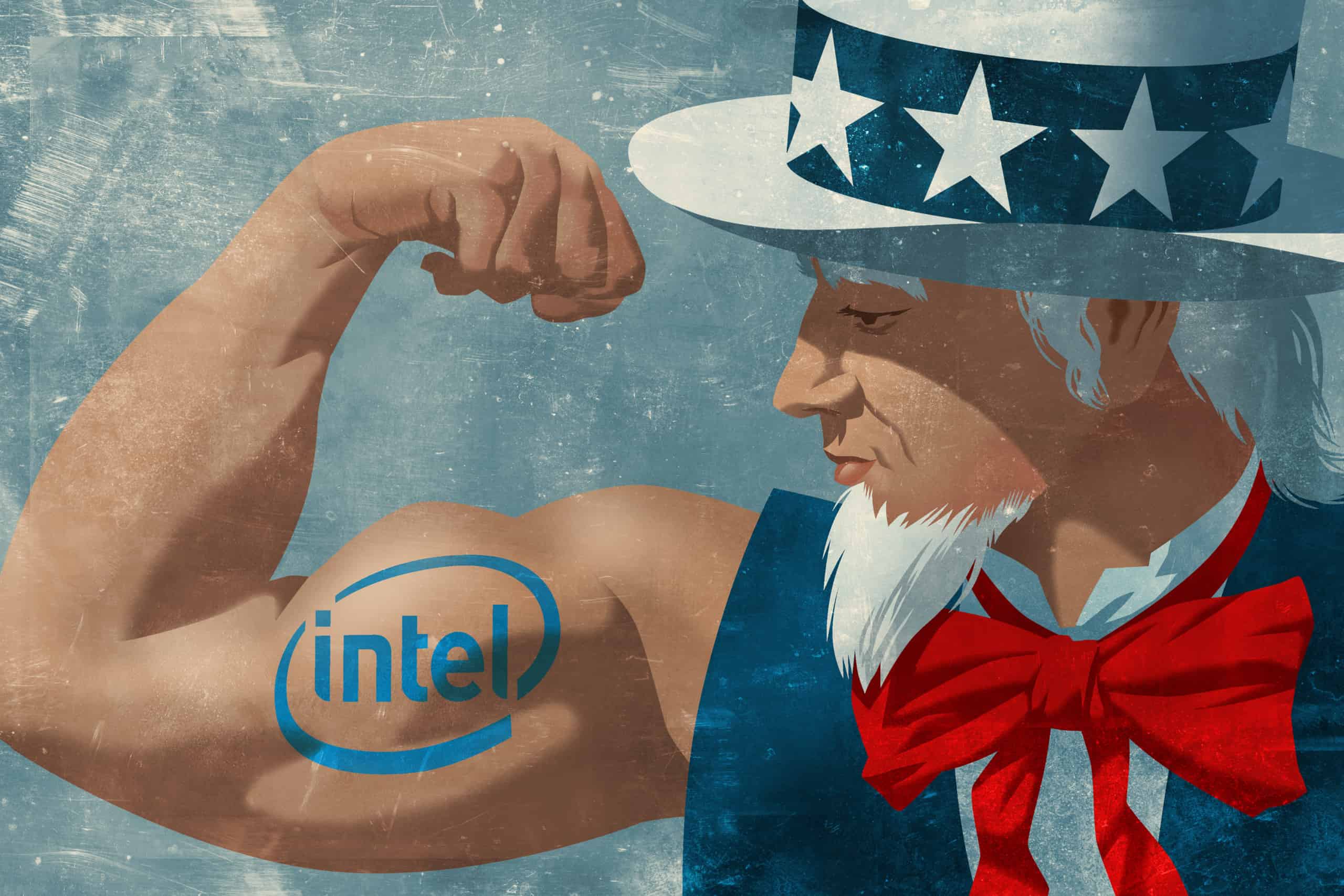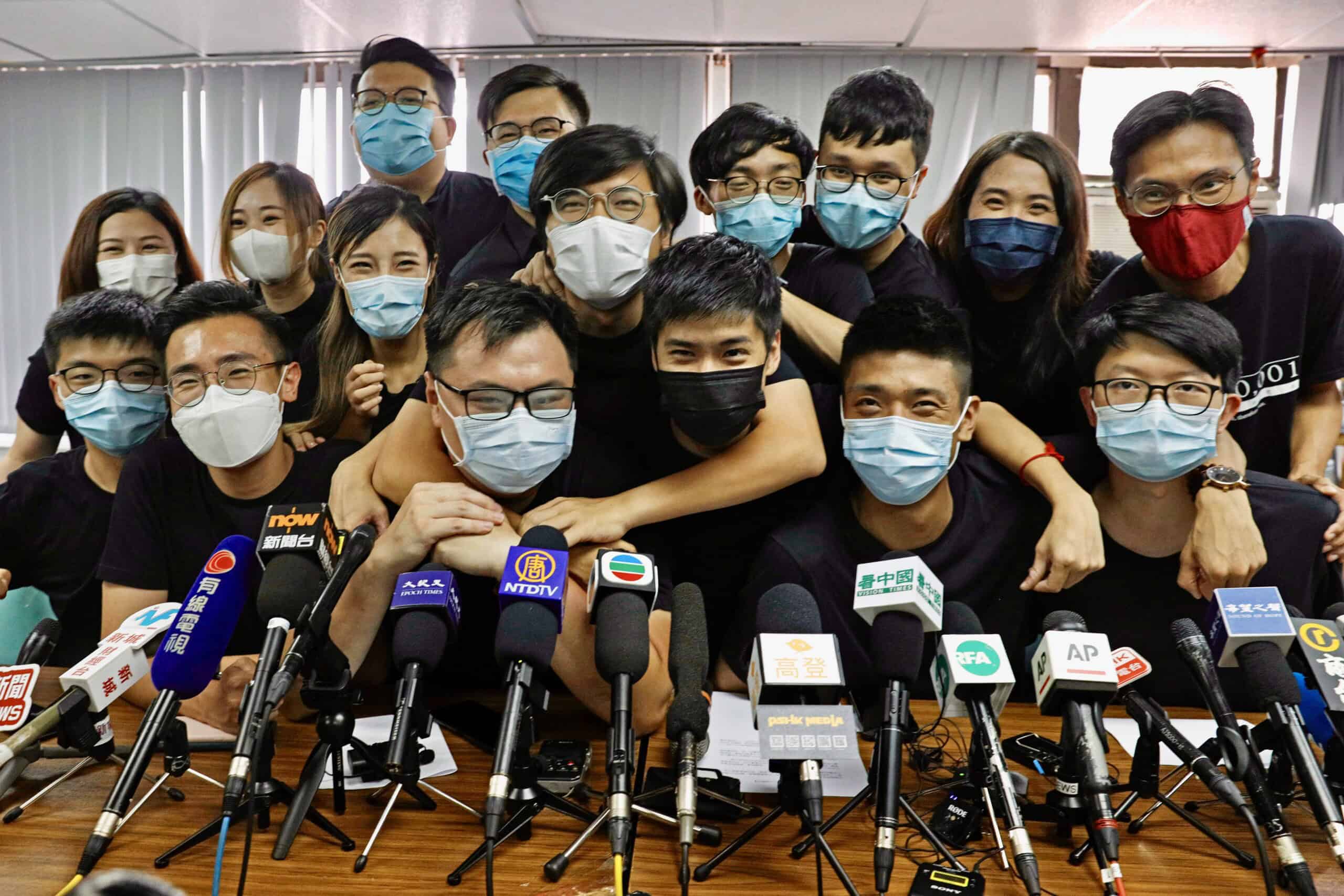
The special guests at the State of the Union are usually valorous veterans or hard-working nurses with extraordinary personal histories. According to a time-honored custom, the president points up to the guests sitting in the House chamber’s balcony and describes their inspiring story to humanize a particular policy.
But this year, President Biden put a different spin on the tradition. He invited the CEO of a massive corporation with $79 billion in annual revenue and 121,000 employees worldwide.
“I don’t know where Pat is,” Biden said, about 20 minutes into his address last month, scanning the room. “There you go. Pat, stand up,” he continued, gesturing to where Patrick Gelsinger, the CEO of Intel, was seated, right between Jill Biden and the Ukrainian ambassador to the U.S., another honored guest for the evening.
“If you travel 20 miles east of Columbus, Ohio, you’ll find 1,000 empty acres of land. It won’t look like much, but if you stop and look closely, you’ll see a ‘field of dreams,’ the ground on which America’s future will be built,” Biden said. “This is where Intel, the American company that helped build Silicon Valley, is going to build its $20 billion semiconductor ‘mega site.’”
The gathered U.S. lawmakers rose to give Gelsinger a standing ovation, and the engineer-turned-executive, dressed in a nondescript suit and his signature nerdy glasses, seemed unsure of the appropriate response. He awkwardly bowed his head, his lips on the edge of a smile.

Gelsinger is no war hero, but due to the confluence of a pandemic-induced semiconductor shortage, a fierce technological rivalry with China, and Intel’s big bet on American manufacturing, he is, nonetheless, the man of the moment.
Semiconductors — tiny chips inside electronics — are foundational to everything from cars and smartphones to missiles and quantum computers. And while there are countless companies involved in the semiconductor supply chain, there are only three companies that can manufacture the most advanced chips: America’s Intel, South Korea’s Samsung Electronics, and Taiwan’s TSMC.
Intel was the original pioneer in the semiconductor industry; in fact, the Santa Clara-based company was seen as so integral to America’s technological innovation that giants like Apple even boasted about having the latest Intel processing power in their devices. In recent years, however, Intel has fallen behind its competitors in Asia, which is currently home to about 75 percent of global chip manufacturing capacity. As a result, the U.S., which still leads in many parts of the semiconductor supply chain, including design and software tools, now has just 12 percent of the world’s chip making capacity (down from 40 percent in 1990) and none of the most advanced chips are manufactured domestically.
Among insiders, the lack of advanced U.S. manufacturing capacity was a known concern, but the Covid-19 pandemic laid it bare for all to see. In addition to Covid shutdowns in factories, which reduced supply, Americans bought an unprecedented amount of electronics, driving up demand for chips. Crippling shortages plagued electronics firms like Apple, which made 10 million fewer iPhones than expected in 2021, and automakers such as General Motors, which was forced to stop production lines and drop more advanced features.
“When the pandemic hit,” says Keith Krach, who was serving as U.S. under secretary of state for economic growth, energy and the environment at the time, “people said, ‘Oh my god.’ Many corporate leaders were caught flatfooted and board members started requesting contingency plans from the CEO and Chief Risk Officers.”
Gelsinger, an Intel veteran who was serving as CEO of VMware, was named CEO of Intel last February, right in the middle of the chip shortage crisis, and he quickly got to work trying to re-establish Intel as the company it once was. He announced a grand new strategy: Intel would plow more than $40 billion into new fabrication plants, known as fabs, in Ohio and Arizona to produce advanced chips, and the company also said it would spend $3.5 billion to expand its facilities in New Mexico. Moreover, Intel — which has manufacturing sites around the world, including fabs in Ireland and Israel and assembly facilities in Malaysia and China — would embrace a foundry model, meaning that the company’s fabs would produce chips with designs from other companies, not just Intel.
“We are setting a course for a new era of innovation and product leadership at Intel,” Gelsinger, 61, said. This “is an elegant strategy that only Intel can deliver — and it’s a winning formula.”
Or rather, Intel hopes it’s a winning formula. Many analysts describe the gambit as a do-or-die scenario for the company, which needs to double down on advanced manufacturing in order to catch up to Samsung and TSMC. With both of its competitors also in the process of building U.S.-based fabs, Intel is leaning into its history as America’s technological darling and volunteering to carry the weight of the country’s expectations on its shoulders.
“Our success is America’s success,” Allen Thompson, Intel’s vice president of U.S. government relations, tells The Wire. “I don’t think that’s hyperbole to say that. We are a U.S. champion, and we’re not going to be ashamed of it.”
Our success is America’s success… I don’t think that’s hyperbole to say that. We are a U.S. champion, and we’re not going to be ashamed of it.
Allen Thompson, Intel’s vice president of U.S. government relations
Intel represents America’s only homegrown shot to reshore advanced semiconductor manufacturing. But while this symbolism has value — as Biden’s parading of Gelsinger illustrated — it remains to be seen how far the U.S. government is willing to go to back Intel. The China competition bill, which both the Senate and House have passed a version of, includes a provision called the CHIPS Act, which would provide $52 billion in subsidies and R&D investment for semiconductor firms. A big unknown, however, is whether foreign companies, like TSMC and Samsung, will get access to the funding.
Both TSMC and Samsung already enjoy significant government support in their respective home countries. Indeed, given how wildly expensive the semiconductor industry is, Biden’s “field of dreams” reference is pretty accurate: if you build the incentives, the chip manufacturers come. This year, for example, after the EU proposed its own CHIPS Act, which would include $49 billion in funding for the industry, Intel announced plans to invest up to $86 billion to build up semiconductor supply chains in Europe.
Intel’s Thompson says that this kind of government support is crucial — and Intel has been missing it in the United States. “There’s about a 30 percent cost differential to make those investments [building fabs] here compared to other parts of the world,” he says. To encourage domestic chip manufacturing, says Thompson, “you need a law like CHIPS, and you need the funding for that to really be able to sustain that.”
This government-led strategy is what China is betting on as well. With very little manufacturing capability at the most advanced nodes, China imported more than $378 billion worth of semiconductors in 2020. (Intel brought in a whopping $21 billion in China revenue, its single largest source.) But the Chinese government, eager to reduce such dependencies and to encourage domestic supply, is plowing an estimated $150 billion into the semiconductor industry from 2014 to 2030. Many experts say that it is only a matter of time before the strategy succeeds and Chinese companies catch up — a threat that has galvanized bipartisan U.S. government support for the semiconductor industry and explains how the CHIPS Act came to be housed in the China competition bill.

“The battleground with China is technology,” says Krach, who is now the chairman of Purdue University’s Krach Institute for Tech Diplomacy, “and semiconductors are the foundation of that. It is no secret that China’s General Secretary Xi is obsessed with the semiconductor industry and sees it as crucial for becoming the global dominant superpower.”
Taken together, the boogie man of China and the shortages of the pandemic have changed the way the U.S. is thinking about government’s relationship to business. While the broader idea of ‘industrial policy’ is complicated and fraught, many experts agree that one of the places it makes sense is with the semiconductor industry — as Taiwan and Korea have both shown. Ivan Kanapathy, who was director for China at the National Security Council until last summer, says, “Many people say you can’t ‘out-China’ China, but on this, you actually do need to ‘out-China’ China.”
| ALSO FROM THE WIRE: Semiconductors | |
|---|---|
| TSMC — The Titan of Taiwan | by Tim De Chant |
| ASML — The Chip Choke Point | by Tim De Chant |
But Stewart Baker, a partner at Steptoe & Johnson and former general counsel to the National Security Agency, notes that “the critical function with industrial policy is don’t dare be too late. If you are going to create a new industry or resuscitate a dead industry, there is a real risk it won’t work. We need to intervene when there are still competitive U.S. manufacturers.”
For Intel, there may not be a moment to lose. Counting the State of the Union, Gelsinger has met with President Biden three times, and his mission, it seems, is to convince the U.S. government that Intel’s predicament is also do-or-die for the nation writ large.
INTEL’S MOVE

Engineers call it Moore’s Law, but many say it is more aptly described as magic — the process of packing more and more transistors, the essential component of semiconductors, onto a chip less than an inch wide. That is the goal of semiconductor manufacturers since increasing the density of transistors enables electronic devices like smartphones to become faster and cheaper while physically shrinking.
Moore’s law is named after the co-founder of Intel, Gordon Moore, and Gelsinger has called Intel the “stewards of Moore’s Law.” But over the last five years, as Intel had trouble and repeatedly delayed rolling out its most advanced chips — called ‘7 nanometer’ chips — speculation swirled that the company had lost its magic touch.
Many analysts attribute the 54-year-old company’s recent failures to a series of technical and business missteps, starting with Intel’s decision in the mid-2000s not to sell its chips to Apple for its new smartphones (the then-CEO of Intel thought Apple was offering a low price). The decision meant Intel lost out on the emerging mobile market, and ceded valuable territory to rivals. TSMC is now a major supplier for iPhone chips.
“When Intel wasn’t in the iPhone, that changed everything,” says Avram Miller, who was an executive at Intel up until the 1990s. “There is no recovering from that. What is ironic is that Andy Grove [Intel’s third employee and CEO at the company from 1987–1998] wrote a book called Only the Paranoid Survive, which was about this exact thing. They did not recognize what could happen with a smartphone.”
As the chip industry changed and became more segmented — with different companies specializing in different parts of the manufacturing process — Intel insisted on controlling every part of its production. Around 2014, for example, Intel announced it would not incorporate new photolithography tools from ASML, a Dutch company that produces equipment for chipmakers, for its 10 nanometer chips. David Yoffie, who was on Intel’s board until 2018 and is a professor at Harvard Business School, says that Intel thought ASML’s systems were too expensive, but without them, the company couldn’t scale to the same extent as its competitors. “TSMC aggressively adopted these new tools,” Yoffie notes. “[Intel] made the mistake of holding on to their own tools.” (Intel’s 7 nanometer chips now use ASML’s tools.)
When Intel wasn’t in the iPhone, that changed everything… There was no recovering from that.
Avram Miller, a former Intel executive
Such specific technical missteps, many analysts say, were part of a broader failure: a business culture at Intel that focused too heavily on stock price. To make technological advancements in the semiconductor space — and therefore stay competitive — companies need to expend an enormous amount of money. But for a publicly traded company that is governed by the logic of shareholder primacy, such costs can seem risky. Intel’s CEO from 2019 to 2021, for instance, was Bob Swan, a former chief financial officer at the company with no background in engineering. Large manufacturing investments, says Yoffie, are “not something that makes a financial person very comfortable.” Indeed, in 2020, Intel faced criticism for purchasing $14 billion in stock buybacks, thus inflating its stock price, while spending only $13.6 billion on research and development that year.
As Intel fell behind, TSMC, which was founded in 1987 and is the first company to solely use the foundry model, began its ascent. “They are the greatest example I can think of a firm being a ‘first mover’ and taking that advantage on for decades,” says Douglas Fuller, a City University of Hong Kong associate professor and author of Paper Tigers, Hidden Dragons: Firms and the Political Economy of China’s Technological Development. “They invented the pure-play foundry model. That is all they do.”
Apple became a major customer for TSMC around 2013 and companies like Qualcomm, AMD and Sony followed suit. Today, TSMC is the ninth most valuable company in the world, with $496 billion in market capitalization. Intel’s, by comparison, is $190 billion.
“Sometimes the train gets off the track,” says Keyvan Esfarjani, the executive vice president in charge of manufacturing, supply chain, and operations for Intel. “Now, for many companies, they just totally fall off the cliff. But this is in our history and in our legacy.”
In 2021, analysts say, Intel took the first step to getting back on track. After ousting Swan, the company appointed Gelsinger, a mentee of Andy Grove and a former chief technology officer at Intel.
Gelsinger had started his career at Intel; as he says, he “went through puberty at Intel” as “a pimply-faced 18-year-old kid.” Eventually, he designed some of the company’s most iconic chips and collected numerous patents. But in 2009, after executive shake ups, he left the company and eventually joined VMware, a cloud computing company, as CEO. It seemed like his time at Intel was over; the devout Christian even got a ‘VMware’ tattoo across his forearm (it was temporary). But as Intel fell further behind technologically, Intel’s board recognized a change was needed.
“He is the guy for the technological comeback,” says Reed Hundt, former Federal Communications Commission chairman who was on the board of Intel until 2020, adding that when the board appointed Gelsinger, they must have known that he would double down on manufacturing and technology advancement. “You wouldn’t ask him if he was going to do this; it is kind of like asking LeBron James if he is a basketball player.”
In addition to the Ohio and Arizona fabs, Gelsinger announced that Intel’s long-delayed 7 nanometer chips would be ready for manufacturing by the end of 2021 (they were) and that Intel’s 20A chips (formerly called 5 nanometer chips) will be ready by 2024. Intel also said that it plans to acquire Tower Semiconductor, an Israeli chip manufacturer, for $5.4 billion, a move that will help Intel produce “legacy” chips, which are less technologically advanced.
While all the experts and analysts The Wire reached out to described Intel’s investments as risky, most agree that the company didn’t have many other options. “There wasn’t really a lot of choice,” says Robert Maire, the president of Semiconductor Advisors, a consulting firm. “Either they do that, or do nothing and let the semiconductor industry move away from them. It is do or die.”
Intel’s Esfarjani admits as much, saying that the foundry model is not in Intel’s “comfort zone,” and yet, “For Intel to be relevant in this semiconductor industry, we have to participate in that growing market [of foundry services].” But Esfarjani also frames the company’s decisions as part of a larger effort focused on the common good. “We absolutely have to do our part to balance the global supply chain challenges facing global customers. The world needs more than just one concentration of the supply of semiconductors.”
That may be true. So far, Amazon Web Services, Qualcomm and Cisco are the largest companies to sign on with Intel. In an earnings call, Cristiano Amon, Qualcomm’s CEO, said of the decision, “I think we all determined that semiconductors are important and [a] resilient supply chain is only going to benefit our business.”
If anyone has the resources and expertise to pull off such a bold play, it would be Intel, but several hurdles remain. First, in addition to attracting more customers, Intel has to attract top talent — which analysts say is difficult with current immigration laws. Intel also has to convince investors that the huge investments in Ohio and Arizona will pay off in the long run. “Will the stock market be patient with the fact that Intel is in a capital intensive industry? You have to invest for many years to have it pay off,” says Hundt.
Meanwhile, TSMC and Samsung are not slowing down or ceding the U.S. market to Intel. In November, Samsung announced a $17 billion investment in a new factory in Texas, and in 2020, TSMC announced a $12 billion investment in a Arizona factory. Now, with CHIPS funding on the horizon, the three seem to be jockeying to woo the U.S. government, with Gelsinger arguing that U.S. companies should get preferential treatment.
“I believe American companies with American IP should get more support [than Taiwanese and Korean companies] from the CHIPS Act … You know, if they get a dollar, I should get more than a dollar,” he said in a December 2021 interview. “And you know, I think that’s politically correct. If I was going to Taiwan, I don’t expect to get treated as good as TSMC does, right? … Industrial policy should clearly be saying: What do we want? Do we want manufacturing in the U.S.? Absolutely. Do we want the intellectual property, R&D, and manufacturing in the U.S.? Even more so.”
TSMC and Samsung, by contrast, have argued that they should receive equal support for their already-planned U.S. investments. “Arbitrary favoritism and preferential treatment based on the location of a company’s headquarters is not an effective or efficient use of the grant,” TSMC wrote in response to the Commerce Department’s request for public comment on semiconductor funding. “TSMC recommends that federal financial assistance be awarded on the merits of the application.”
Intel does, of course, have one leg up on its home turf: securing U.S. government and military contracts. But with only 4 percent of global semiconductors used for government purposes, Intel will need more than just the government’s purchases for support. It will need the government to believe that Intel can do for American innovation what it did back in 1968, the year it was founded.
“From the company that helped create Silicon Valley,” Gelsinger told the U.S. Senate Commerce Committee in a March testimony about Intel’s new Ohio fab, “we are now creating the Silicon Heartland.”

Design by Eliot Chen
THE INDUSTRIAL POLICY U-TURN
In 2010, Andy Grove, Gelsinger’s mentor and the legendary former CEO of Intel, wrote a remarkably prescient essay in Bloomberg entitled “How America Can Create Jobs.” The piece opens in a Silicon Valley restaurant with Grove being introduced to a group of Chinese investors — an interaction that leaves him feeling unsettled given that, at the time, “for every Apple worker in the U.S. there are 10 people in China working on iMacs, iPods, and iPhones.”
Grove then uses the essay to push back against the prevailing notion that American innovation is rooted in garage-based start-ups, and that outsourcing manufacturing labor to China is wise so long as the “knowledge work” stays in America. As he argues, in the transition from start-up to tech giant, a lot more than just U.S. jobs is at stake.
“Without scaling, we don’t just lose jobs — we lose our hold on new technologies,” he wrote. “Losing the ability to scale will ultimately damage our capacity to innovate.”
Grove, who died in 2016, cites outsourcing the manufacturing of solar panels, lithium ion batteries and even televisions as mistakes not only because of U.S. job losses, but because of the loss of technical experience: “abandoning today’s ‘commodity’ manufacturing,” he wrote, “can lock you out of tomorrow’s emerging industry.”
Not many people were listening back then, and Grove even foresaw his critics’ calling him “protectionist.” But today, Grove’s piece echoes the growing consensus in Washington. While supply chains used to be set up to maximize efficiencies and bottom lines, they are now reorienting towards long term strategies, such as security and competitiveness.
“A couple of years ago, I would have railed in favor of efficiency,” says Willy Shih, a professor at Harvard Business School. “A lot has happened — even in the past few weeks! — to say that efficiency may not be the best answer. Supply chains used to be one of these stable topics but, boy, the thinking is changing very quickly now. It seems to me we are seeing a regionalization of the semiconductor industry.”
Given that such regionalization doesn’t easily happen without incentives from the government, Grove also addressed the bitter pill of industrial policy in his 2010 essay, in an attempt to make it easier to swallow.
“Our generation has seen the decisive victory of free-market principles over planned economies,” he wrote, noting that he himself fled Communist-controlled Hungary as a young man. “So we stick with this belief, largely oblivious to emerging evidence that while free markets beat planned economies, there may be room for a modification that is even better.”
Now, more than ten years later, the chip shortage has made it almost impossible to be oblivious. Robert Atkinson, the president of the Information Technology and Innovation Foundation, a think tank focusing on science and technology policy, says that the changing opinion on industrial policy is “a bit like a U-turn.”
“There used to be a conversation [about the merits of industrial policy] back in the ’80s, when the U.S. faced stiff competition from Japan. And then it went away, and the view in D.C. was that it is bad. But the competition, particularly in technology, with China has made people think we need a national strategy. It is all China.”
Intel’s Thompson, for his part, is reluctant to call the government’s semiconductor support “industrial policy.” Instead, he calls it “a strategic need to recognize that we have to have capabilities to be successful in the long term.” He also says that it is not only about China. “Does China play a role? Yes,” he says, “but it’s also a bigger competition now beyond them.”

Regardless of what you call it, the CHIPS Act shows Washington wants to get its hands dirty when it comes to the $556-billion global industry.1In addition to the CHIPS Act, another piece of legislation, the FABS Act, was introduced in the House just last month, which would give semiconductor companies further support in the form of tax credits for building fabs. Proposed in the act is the creation of an interagency committee that would be tasked with establishing a semiconductor strategy as well as a National Semiconductor Technology Center, a public-private consortium that would be tasked with pushing forward innovation. And, of course, the act would provide financial incentives, in the form of grant subsidies, for semiconductor companies to set up fabs.2State-level incentives play an important role as well; Ohio, for example, promised $2.1 billion to Intel for its fab projects there.
Although it’s not yet clear how the $52 billion from the act will be split between different companies, Will Hunt, a semiconductor analyst at Georgetown’s Center for Security and Emerging Technology, says Asian companies should be in the running. “It doesn’t make sense to put all your eggs into the Intel basket,” he says.
But, given its unique position as an American company, Intel’s Thompson is optimistic about their advantage. “I can’t speak to what the Commerce Department will decide,” he says, “but I think if you look at our investments in Arizona, New Mexico and Ohio, and the work that we do from an R&D standpoint in Oregon, I feel pretty good that we will make a compelling case to the U.S. government.”
If it does, Intel will then be on the hook to deliver, which some skeptics of industrial policy argue is harder than it looks. Chang-Tai Hsieh, an economist at University of Chicago’s Booth School of Business, thinks the CHIPS Act will only provide money to large corporations without helping the semiconductor shortage or the tech competition with China. China’s own industrial policy has not yet been successful, after all. “There is a sense in which what the administration is doing is looking at Chinese industrial policy,” he says. “But if you look at the results of that industrial policy, it has been a complete failure. Despite all the billions poured in, what has happened? China is not a major player in semiconductors.”
Of course, that is partly because the U.S. has already deployed defensive strategies by subjecting Chinese semiconductor firms to intense export controls, including on the ASML lithography machine, which experts say hinders their technological progress. But to Hsieh’s point, ultimately, no matter how much government assistance a company receives, companies like Intel still have to produce the technology. As Hundt notes, “The companies need to perform the magic. The government can’t do that.”

Katrina Northrop is a journalist based in Washington D.C. Her work has been published in The New York Times, The Atlantic, The Providence Journal, and SupChina. @NorthropKatrina



